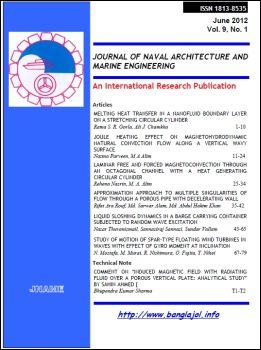Melting heat transfer in a nanofluid boundary layer on a stretching circular cylinder
DOI:
https://doi.org/10.3329/jname.v9i1.7416Keywords:
stretching cylinder, melting heat transfer, nanofluidAbstract
A boundary layer analysis is presented for the warm, laminar nanoliquid fluid flow to a melting cylindrical surface moving parallel to a uniform stream. The resulting system of non-linear ordinary differential equations is solved numerically using Runge-Kutta method with shooting techniques. Numerical results are obtained for the velocity, temperature and concentration distributions, as well as the friction factor, local Nusselt number and local Sherwood number for several values of the parameters, namely, the Reynolds number, Prandtl number and nanofluid parameters. The obtained results are presented graphicallyand in tabular form and the physical aspects of the problem are discussed.
DOI: http://dx.doi.org/10.3329/jname.v9i1.7416
Journal of Naval Architecture and Marine Engineering 9(2012) 1-10
Downloads
References
Chamkha, A.J., Abd El-Aziz, M.M. and Ahmed, S.E. (2010): Effects of Thermal Stratification on Flow and Heat Transfer Due to a Stretching Cylinder with Uniform Suction/Injection, Int. J. Energy & Technology, Vol. 2, pp. 1-7.
Choi SUS (1995): Enhancing thermal conductivity of fluids with nanoparticles: In Proceedings of the 1995 ASME International Mechanical Engineering Congress and Exposition, November 12-17, 1995. ASME, San Francisco, CA, USA.
Crane, L. J. (1962): Flow Past a Stretching Plate, ZAMP, Vol. 21, pp. 645-647.
Eastman, J. A., Choi, S.U.S. Li, S., Yu, W. and Thompson, L.J. (2001): Anomalously Increased Effective Thermal Conductivities Containing Copper Nanoparticles, Applied Physics Letters, Vol. 78, pp. 718-720.
Gorla, R.S.R. and Sidawi, I. (1994): Free Convection on a Vertical Stretching Surface with Suction and Blowing, Applied Scientific Research, Vol. 52, pp. 247-257.
Huang, C.L. and Shih, Y.P. (1975): Perturbation Solution for Planar Solidification of a Saturated Liquid with Convection at the Wall, International Journal of Heat and Mass Transfer, Vol. 18, pp. 1481-1483.
Lee JK, Hwang YJ, Ahn YC, Shin HS, Lee CG, Kim GT, Park HS (2006): Investigation on characteristics of thermal conductivity enhancement of nanofluids. Curr Appl Physics, Vol. 6, pp. 1068-1071.
Pedroso, R.I. and Domoto, G.A. (1973): Perturbation Solutions for Spherical Solidification of Saturated Liquids, Journal of Heat Transfer, Vol. 95, pp. 42-46.
Sakiadis, B. C. (1961): Boundary-layer behavior on a continuous solid surface: II-The boundary layer on a continuous flat surface, AIChE Journal, Vol. 7, pp. 221-225.
Tsou, F. K., Sparrow, E. M. and Goldstein, R. J. (1967): Flow and Heat Transfer In The Boundary Layer in the Continuous Moving Surfaces, Int. J. Heat Mass Transfer, Vol. 10, pp. 219-235.
Wang, C.Y. (1988): Fluid Flow Due to a Stretching Cylinder, Physics of Fluids, Vol. 31, pp. 466-468.
Downloads
Published
How to Cite
Issue
Section
License
Please download the Copyright Transfer Agreement and send it after duly filled in.
Link to FaceBook


